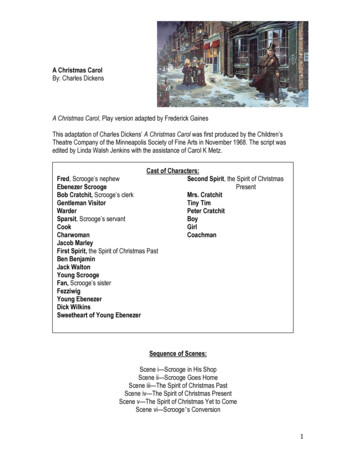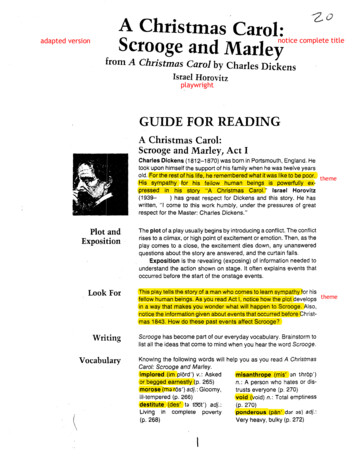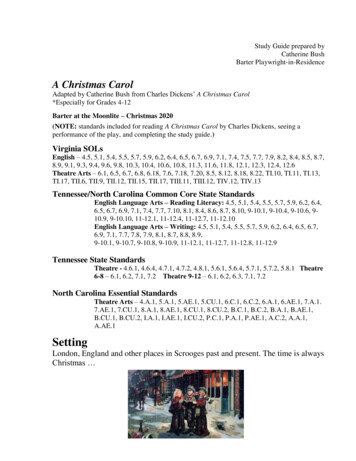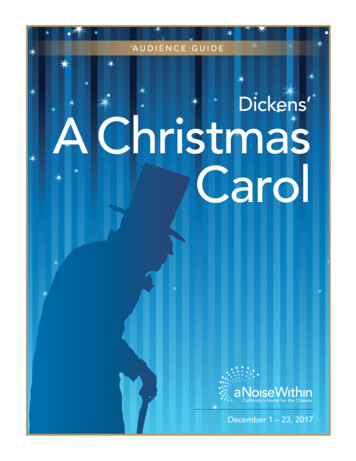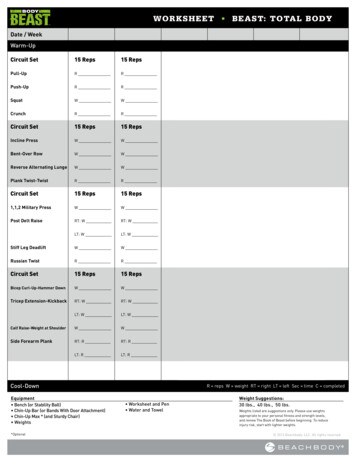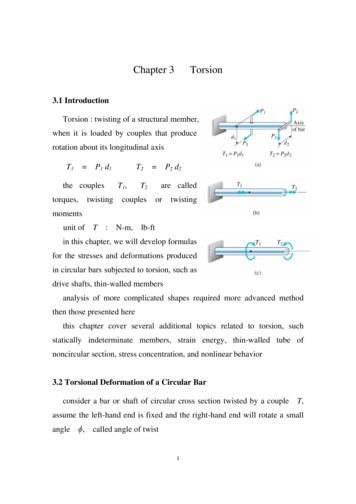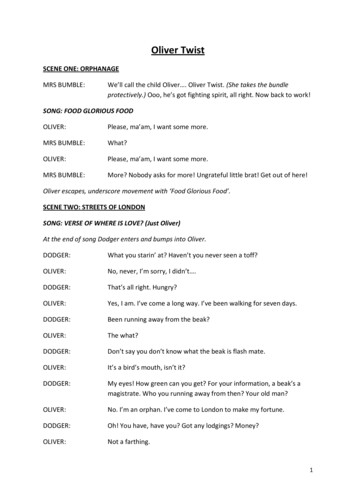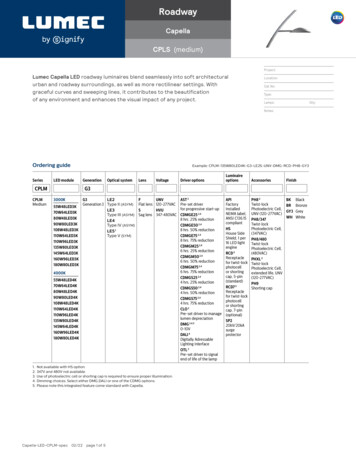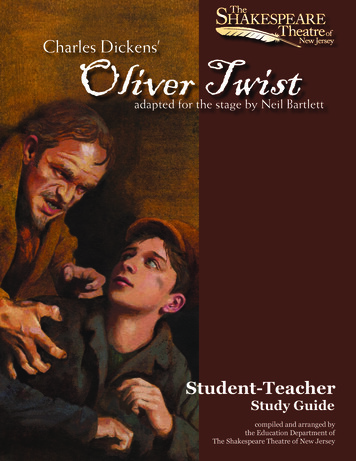
Transcription
Charles Dickens’Oliver Twistadapted for the stage by Neil BartlettStudent-TeacherStudy Guidecompiled and arranged bythe Education Department ofThe Shakespeare Theatre of New Jersey
The Shakespeare Theatre of New JerseyCHARLES DICKENS’ OLIVER TWIST: Student/Teacher Study GuideIn This Guide:Classroom Activities for Teachers and Students . p2Oliver Twist: A Brief Introduction. p3Who’s Who in Oliver Twist . p5Director’s Notes. p6The Life of Charles Dickens . p7Charles Dickens: A Selective Biography . p8Dickensian Times . p9About the Adaptor .p10Neil Bartlett on Oliver Twist .p11Commentary and Criticism .p12Terms and Phrases in Oliver Twist .p13Child Labor in Dickens’ England .p14Interviews with Former Child Laborers .p15Child Crime in Nineteenth-Century London.p16Jews in Nineteenth-Century England .p17“Who Said That?” Quiz .p17“Test Your Understanding” Quiz .p17About The Shakespeare Theatre of New Jersey.back coverCover Artwork: Madrid Artist Enrique Moreiro was specially commissioned to create the uniqueportraits used for The Shakspeare Theatre of New Jersey’s 50th Anniversary Season.
The Shakespeare Theatre of New JerseyCHARLES DICKENS’ OLIVER TWIST: Student/Teacher Study GuideC L A S S R O O M TSACTIVITIESFOREACHERS ANDTUDENTSSome of the principal goals of The Shakespeare Theatre of New Jersey’s education programs is to demystify the classics,take them “off the shelf” and re-energize them for students and teachers alike. Toward these goals, this study guideprovides educators with tools to both allay their own concerns and to expand the theatre-going experience for theirstudents beyond the field trip to The Shakespeare Theatre.The information included in this guide will help you expand your students’ understanding of the classics in performance,as well as help you meet many of the New Jersey Core Curriculum Content Standards. We encourage you to impartas much of the information included in this Study Guide to your students as is possible. The following are somesuggestions from teachers on how you can utilize elements of the guide given limited classroom time. Many teachers have found that distributing or reading the Short Synopsis and Who‘s Who pages has greatlyincreased students’ understanding and enjoyment of the production. It provides the students with a generalunderstanding of what they will be seeing and what they can expect. Some teachers have simply taken the lastfive minutes of a class period to do this with very positive results. When more class time is available prior to your visit, we recommend incorporating the background informationon the author, the playwright and the play itself. One teacher divided her class into groups and assigned eachgroup research topics based on the divisions found in the study guide. Using a copy of the corresponding studyguide page as a launch pad, the students had one week to research the topics. The students then presentedtheir information to the class in three- to five-minute oral reports. Including the questions that evolved fromthe presentations, the entire project took only one class period. Using the questions found in the “TOPICS FOR DISCUSSION,” many teachers will opt to take a class period afterthe trip to The Shakespeare Theatre to discuss the play with their students. The questions help keep thecomments focused on the production, while incorporating various thematic and social issues that are found inthe play.Again, we hope you will incorporate as many portions of this study guide as you are able into your classroom experience.If you have any suggestions for activities or topics not already found in the study guide, please contact our educationdepartment. We are always interested in hearing new ways to excite young people (and teachers) about the classicsand live theatre.Happy Teaching,“What’s My Line?”Promoting Active ListeningTeacher-tested, student-approved!Try this exercise with your students:Brian B. Crowe,Director of EducationBefore attending the production, give each student one linefrom the novel/play to listen for. Discuss the meaning of the lineand encourage their input in deciphering what the author andplaywright meant by the line. How would the student performthe line? Why is the line important to the play? Does it advancethe plot, or give the audience particular insight into a character orrelationship?Following the production, discuss the line again. Did the actorpresent the line in the way your student expected? If not, howwas it different?-2-The Shakespeare Theatre of New Jersey’sMain Stage, The F.M. Kirby Shakespeare Theatre.
The Shakespeare Theatre of New JerseyCHARLES DICKENS’ OLIVER TWIST: Student/Teacher Study GuideOliver Twist: A Brief IntroductionOliver Twist originated as a serial novel, but it has since beenadapted into many other forms. Neil Bartlett ’s theatricaladaptation reduces Dickens’ fifty-three chapter novel to acollection of twenty-four scenes. Omitted sections from thenovel include Oliver’s summer spent in the country and histime with his devious half-brother Monks. Other details arealtered or combined – for example, in the novel, Mr. Brownlowis not Oliver’s grandfather, though he does adopt the orphanat the story’s end.Sowerberrys’other workers,Noah Claypoleand Charlotte,Oliver attacks histormentors and islocked in a coffin.Oliver eventuallyescapes theSowerberrysand makes thelong journey toLondon. Along theway, he meetsthe Artful Dodger,a pickpocket whobefriends the boyand leads Oliverthrough LondonCostume renderings of the Artful Dodger andto meet Fagin, aOliver, by designer Nancy Leary.snakily charmingbut sinister “collector” of stolen goods. Fagin and his gang ofchild pickpockets feed and shelter the weak, exhausted boy. Itseems to be the first caring home he has ever known. The nextday, Oliver plays a type of pickpocketing game with Fagin andthe boys, though he does not realize they are indoctrinatinghim into their world of thievery. The gang heads to the streetsto pickpocket the citizens, and Oliver goes along to observe.The Dodger and another pickpocket, Charley Bates, show Olivertheir cunning as they steal a handkerchief from the pocket of akind old man and flee the scene. Oliver, horrified by the theft,stands stock still in shock and amazement, and he is blamed forthe crime.Oliver Twist begins with the birth of the title character in aparish workhouse. Because his mother died in childbirth leavingno clue of the boy’s family origins – save for a locket stolen fromthe corpse by Mrs. Corney – Oliver is raised in the workhouse.When he is ten years old, Oliver approaches Mr. Bumble, aparish Beadle, to request another meager serving at dinner.Horrified by the child’s audacious request, the workhouse Boarddecides that the troublesome child will be sold to “anybodywho will take Oliver Twist off the hands of [the] Parish.” Oliveris sold as an apprentice to Mr. and Mrs. Sowerberry, who areundertakers for the parish. Following the cruel taunts of theAn Installment Plan for LiteratureA serial novel is any novel that has been printed ininstallments. One might think of these as a weekly seriesof the story versus a full-length feature film. Most often,chapters are printed in a regularly published magazine,newspaper or other periodical.Serialized fiction surged in popularity during Britain’s Victorianera. This was in part due to the rise of literacy, technologicaladvances in printing, and the improved economics ofdistribution. With the price of published books still expensive,a serial format proved to be a more appealing way to reacha wider audience. Many significant major works of theVictorian era first appeared in either monthly or weeklyinstallments in magazines or newspapers. Charles Dickens’The Pickwick Papers, first published in 1836, is creditedwith launching the wild success of the serial format. Manyof Dickens’ other novels, including David Copperfield, HardTimes, and A Tale of Two Cities, all first appeared as serialpublications.When brought before the cruel court of Magistrate Fang, Mr.Brownlow (the victim of the theft) states that he is in doubtthat Oliver is the pickpocket after all. A last minute witnessverifies that two other boys committed the theft, and Oliveris released. Mr. Brownlow takes pity on the ailing orphan andtakes him in. He and his daughter, Rose, nurse Oliver back tohealth. Meanwhile, Fagin worries that Oliver might expose hisgang, and he sends Nancy, a trusted member of his gang, tobring Oliver back to the hideout. She finds the boy carryingout an errand for Mr. Brownlow and whisks him away to Fagin,where he is held captive. Devastated by Oliver’s disappearance,-3-
The Shakespeare Theatre of New JerseyCHARLES DICKENS’ OLIVER TWIST: Student/Teacher Study GuideTwist TransformationsRose Brownlow offers a reward in the paper forany information regarding Oliver’s whereaboutsor history. Mr. Bumble and Mrs. Corney, nowmarried, resolve to tell Mr. Brownlow what theyknow about Oliver’s origins and claim the reward.Dickens’ Oliver Twist has seen manyadaptations, including numerous films and atelevision mini-series, but perhaps the mostfamous work based on this novel is Oliver!This award-winning musical adaptationpremiered on London’s West End in 1960,moving to Broadway in 1963. It was turnedinto an Academy Award winning movie in1968. It remains the most oft-produced musicaladaptation of any of Dickens’ works.Nancy also sees the posting, and she tells Rosethat Oliver is safe but hidden. Rose convincesNancy to give her weekly updates on Oliver’s wellbeing, and Nancy agrees. Meanwhile, Oliver ismade to assist the brutal Bill Sikes with an out-oftown burglary, which takes longer than expected,leaving Fagin to worry about Oliver’s fate. WhileNancy sneaks out to keep her appointmentwith Rose, the Bumbles meet Mr. Brownlow, expectingreward money for the locket stolen from Oliver’s mother. Mr.Brownlow recognizes the locket immediately; it belonged tohis long-dead daughter, and he vows to prosecute the Bumblesfor withholding such important information that might haverestored Oliver to his family long ago.That night, meeting with Rose and Mr. Brownlow on LondonBridge, Nancy agrees to help Oliver escape, provided that theBrownlows do not seek out Fagin, Bill, or the gang. They agree,and Rose also tries to convince Nancy to leave Bill, but Nancyrefuses. Unbeknownst to Nancy and the Brownlows, the Dodgerhas witnessed the entire conversation. He tells Fagin, whorepeats the report to Bill. Bill confronts Nancy and in a rage, hekills her.News of the brutal murder races through London, and Billbecomes a wanted man. Fagin is arrested as an accessory to themurder and is sentenced to be hanged. Bill holds Oliver hostageon a rooftop as a mass of citizens gather to capture him. He diesin a failed escape attempt, and Oliver is returned to the care ofthe Brownlows. Fagin, in prison, worries about the fate of hisgang, and when Mr. Brownlow brings Oliver to see him, Fagin,mad with fear, seeks Oliver’s aid in his escape. He is denied.Oliver returns to life with the Brownlows, his true family, andthey live happily. The fate of the rest of the characters is laid outas the story concludes.Costume renderings of Mr.Brownlow and Rose, bydesigner Nancy Leary.-4-
The Shakespeare Theatre of New JerseyCHARLES DICKENS’ OLIVER TWIST: Student/Teacher Study GuideWho’s Who in Oliver TwistCHARLOTTE – servant to Mrs. Sowerberry; she also tormentsOliver.OLIVER TWIST – a poor orphan boy born in a workhouse; inhopes of finding a better life, he escapes his cruel keepersand finds his way to London.FAGIN – a seemingly pleasant old Jewish man who leads a groupof child pickpockets and housebreakers.MR. BUMBLE – a Parish Beadle (or minor official of a smallgovernment faction) who runs the workhouse in whichOliver is raised.JOHN DAWKINS, THE ARTFUL DODGER – a charming youngpickpocket who leads Oliver to Fagin.MRS. CORNEY – a matron of the workhouse; she steals Oliver’smother’s locket and later marries Mr. Bumble.BILL SIKES – a brutal thief who collaborates with Fagin and takesOliver to help with a burglary; Nancy’s keeper.MR. SOWERBERRY – an undertaker who buys Oliver from Mr.Bumble and attempts to make him an apprentice.NANCY – a young prostitute and thief in Fagin’s service; she is in arelationship will Bill Sikes.MRS. SOWERBERRY – a sour, vixenish woman; Mr. Sowerberry’swife.CHARLEY BATES – a thief; one of Fagin’s apprentices.TOM CHITLING – another one of Fagin’s thieves and apprentices.NOAH CLAYPOLE – a poor student of a charity schoolapprenticed to Mr. Sowerberry; he torments and is attackedby Oliver.TOBY CRACKIT – a housebreaker working for Fagin.MR. BROWNLOW – a benevolent old gentleman who takes Oliverin; unknowingly Oliver’s grandfather.ROSE BROWNLOW – Mr. Brownlow’s daughter; she meets withNancy to try to find and rescue Oliver.MR. GRIMWIG – a friend of Mr. Brownlow’s who doubts Oliver’scharacter.MR. FANG – a drunken, overbearing police-magistrate whooversees the case against Oliver.What’s in a Name?One can often get a sense ofDickensian characters just byknowing their names. “Mr. Bumble,”for instance, paints an immediatepicture of an ineffectual man.The name “Sowerberry” is just asunappealing as is the Sowerberryfamily. Sometimes, though, it isnot as clear why Dickens chose aparticular name. In the case of Fagin,it is possible that he was named aftera childhood co-worker of Dickens’, orperhaps “Fagin” is an anagram of theYiddish word for thief, ganif.A selection of George Cruikshank’s originalillustrations for Oliver Twist.-5-
The Shakespeare Theatre of New JerseyCHARLES DICKENS’ OLIVER TWIST: Student/Teacher Study GuideDirector’s NotesBefore working on this production, I, like so many, had Technicolor memories of the poor orphaned Oliver and hisnearly magical journey to a safe and nurturing home. My fondest recollections of the 1968 award-winning musicalfilm adaptation of Dickens’ novel were the comically inept and somewhat toothless Mr. Bumble; the charming, craftyand colorful Fagin; and the saucy Nancy –a tavern-wench with a heart of gold. Who wouldn’t want to join Fagin’smerry gang of singing urchins when viewed through the lens of a Cinemascope epic? Years later, when I returned tothe original serialized novel, I was taken aback by the unabashed brutality with which Dickens treated his subject.Though sometimes reaching to such extremes as to be comically absurd, it was brutal nonetheless. The malevolenceand violence of the seedy pre-Victorian underworld that Dickens so accurately describes in his novel allow the fewglimmers of hope that radiate in this tale to shine that much more brightly.In his adaptation for the stage, Neil Bartlett has artfully included much of the dark underbelly of Dickens’ novel whichis typically lost in other adaptations. He has done this, however, without losing the highly theatrical nature of Dickens’biting sarcasm, cutting wit and humor and social commentary. Raised in a well-educated and decidedly middle classsociety, the young Dickens’ world was turned upside-down when, at age 12, he was forced to work in a shoe-polishfactory, while his family was placed into a debtors’ prison for debts incurred by his thriftless father. Though it was arelatively short period of his life, the experience scarred the adolescent Dickens and shaped the man and the writer hewould become. The ghosts of his time among the uneducated and disadvantaged masses permeated much of his life’swork – both literary and civic – and are quite palpable in Oliver Twist, his second major literary endeavor, pennedwhen Dickens was only 25 years old.In Bartlett’s adaptation (as in Dickens’ original text), we are given the opportunity to explore anew these iconiccharacters that have been indelibly stamped into our common cultural consciousness. Oliver is not merely an ineffectual waifish innocent, but rather a child who attempts to do what is right and honorable in the face of adversitiesthat might have crushed a boy of lesser character. The Nancy of the novel, a young world-weary prostitute trapped in acruel relationship, is initially cold towards the young orphan and announces that she wishes he were dead because hispresence “turns me against myself.” Fagin is a manipulative, cruel, self-serving old man who creates a bastardizationof a family for his “good boys” – good boys who, he notes thankfully, “never bring any awkward stories to light” whenthey are caught. As Bartlett states at the conclusion of his play:This tale’s involved the best – and worst – shades of our natures;The ugliest – also, the loveliest – of all God’s created creatures; Namely, in little Oliver, the principle of Good;Good, surviving, and triumphing at the last;And Hope Hope flourishing, where all hope was past.Brian B. Crowe, Director-6-
The Shakespeare Theatre of New JerseyCHARLES DICKENS’ OLIVER TWIST: Student/Teacher Study GuideThe Life of Charles DickensCharles Dickens was born February 7, 1812, the second childof John and Elizabeth Dickens. (His beloved older sister, Fanny,would be immortalized in A Christmas Carol as Scrooge’s sister,Little Fan). John Dickens was a civil servant, who worked as aclerk in the Navy Pay Office at the time of Charles’ birth.the family was placed with him in the Marshalsea Debtors’Prison. Charles was left to fend for himself on his six shillingsa week, barely enough for him to eat, let alone to helpsupport his family.For five grueling months, Charles Dickens worked long,tedious days in the rat-infested warehouse. This traumaticexperience left deep emotional scars, and Dickens was soashamed of his family’s situation that he talked about hisexperiences at the factory to only two people during his life.Nevertheless,the experience had a profound impact on hiswriting as well as his subsequent fierce devotion to socialwelfare, especially when it involved children and education.His time in the factory also ingrained in him a sense ofloneliness and isolation with which he struggled throughouthis life. As his fictional alter ego, David Copperfield, putit, “I had no advice, no counsel, no encouragement, noconsolation, no assistance, no support, of any kind, fromanyone.”In 1817, John Dickens was assigned to the huge Navy shipyardsin Chatham, Kent. During the family’s five years in Chatham,Charles started school, beginning his lifelong love affair withbooks. It was at this time that he also discovered the theatre,which he regularly attended with his uncle. Later he describedthis as the happiest period in his childhood, and moved back tothe vicinity of Chatham as an adult.By 1822, however, there were six Dickens children, and thefamily’s finances, always stretched thin by John Dickens’inability to live within their means, took a further blow when hewas transferred back to London. The family relocated to a fourroom house in the seedy neighborhoodof Camden Town. By 1824, their situationwas so precarious that 12-year-old Charleswas pulled out of school and sent to workfull-time in a shoe-polish factory. Elevendays after Charles began work at thefactory, John Dickens was imprisoned fornon-payment of debts, and the rest ofBy June of 1824, John Dickens wasreleased from prison and Charles wasable to return to school for a few moreyears. As a teenager, he again foundwork to support himself, first as a clerkin a law office, then as a newspaperreporter. He was eventually assignedto cover sessions of Parliamentas a court reporter, and he taughthimself shorthand in order to takeaccurate transcripts of the speechesand debates. These skills won hima reputation as London’s fastestParliamentary reporter.During this time, Dickens began writing short stories formagazines, and then novels in the new serial format.Books were still fairly expensive items in Dickens’ time, butthe introduction of serialization made literary works farmore available to a wide middle and lower-middle classaudience. Essentially, serial novels were stories purchasedABOVE: A bust of Dickens, made by sculptor Henry Dexter during Dickens’ 1842trip to America, not long before he wrote A Christmas Carol. According to hiswife and friends, it was extremely lifelike. This cast of the lost original is in thecollection of the Dickens Museum in London.LEFT: A photograph of Charles Dickens taken in 1850. From the collection of theHuntington Library, San Marino, CA.-7-
The Shakespeare Theatre of New JerseyCHARLES DICKENS’ OLIVER TWIST: Student/Teacher Study GuideIn 1865, Dickens was involved in a terrible train derailment thatkilled 10 people and seriously injured 49 others. Dickens (whosetrain car had tipped but not overturned) went to the aid of theinjured passengers until rescuers arrived, then clambered backinto his own carriage to retrieve his half-finished manuscript forOur Mutual Friend. While he had seemed relatively unscathedat the time, hishealth was nevergood followingthe accident, andin June of 1870he suffered astroke and diedat home. He waslaid to rest in thePoets’ Cornerof WestminsterAbbey, in a tombthat reads: “Hewas a sympathizerto the poor, thesuffering, and theoppressed; and byhis death, one ofEngland’s greatestwriters is lost toCostume renderings of Toby Crackit and Tomthe world.”Chitling, by designer Nancy Leary.on an installment plan, a few chapters at a time. Charles Dickensbecame a master of this form, skillfully building suspense andinserting tantalizing details in each chapter.In 1836, shortly after publishing his first novel, The PickwickPapers, Dickens married Catherine Hogarth, the daughter ofa newspaper editor. They would go on to have ten childrentogether before separating in 1858.Between 1836 and 1865, Dickens worked extensively. Hepublished several novels which met with extraordinary popularsuccess, while also publishing and editing two magazines.His speaking engagements in the United States, Canada, Italyand Switzerland were extremely popular, and he managed topurchase a large house in Gad’s Hill, near his childhood homein Chatham. Nevertheless, maintaining this upper middleclass lifestyle with such a large family proved to be a continualchallenge, and Dickens frequently worked to the point ofexhaustion.Charles Dickens has been dubbed the first real “celebrityauthor” by literary historians, and he used this status tovehemently criticize social injustices in Victorian England;from the slum conditions in which many people lived to themaltreatment of child laborers, prisoners, and others. He is stillone of the most popular and widely read English authors, andnot one of his books has ever gone out of print.Charles Dickens: A Selective BibliographyWhere applicable, dates are based on when the first installment of a work was published.The Pickwick Papers (1836)Dombey and Son (1846)The Adventures of Oliver Twist (1837)The Haunted Man and the Ghost’s Bargain (1848)The Life And Adventures of Nicholas Nickleby (1838)David Copperfield (1849)Barnaby Rudge (1841)Bleak House (1852)Master Humphrey’s Clock (1841)Hard Times: For These Times (1854)A Christmas Carol (1843)Little Dorrit (1855)The Life and Adventures of Martin Chuzzlewit (1843)A Tale of Two Cities (1859)The Chimes (1844)Great Expectations (1860)The Cricket on the Hearth (1845)Our Mutual Friend (1864)The Battle of Life (1846)The Mystery of Edwin Drood (1870) - incomplete-8-
The Shakespeare Theatre of New JerseyCHARLES DICKENS’ OLIVER TWIST: Student/Teacher Study GuideDickensian Times: A ChronologyLike most authors, Charles Dickens’ work was heavily influenced by the time in which he lived and wrote. Living at the rise of one ofthe most impactful periods in the history of western culture, it is interesting to note the major achievements that were happeningaround Dickens as he penned his many masterworks.1807:Robert Fulton invents the first successful steamboat. Slavery is abolished in England.1812:Charles Dickens is born in Portsmouth, England.1815:The Battle of Waterloo ends the Napoleonic Wars.1824:Dickens’ father and family are imprisoned for debt, while 12-yearold Charles begins a full-time job at Warren’s Blacking Factory.1825:Trade unions are legalized in England.1827:The Dickens family is evicted from their new home for failing tomake their mortgage payments. Charles leaves school for good and begins work as a clerk in a law office.1830:The world’s first commercial railway, the Liverpool and Manchester Railway (above right), begins operation.1834:Dickens becomes a reporter for the Morning Chronicle and meets his future wife, Catherine Hogarth.Parliament enacts the Poor Law Amendment, making the conditions of England’s public assistance shelters deplorable.1836:Dickens marries Catherine Hogarth, and publishes Sketches by Boz and his first serial novel, The Pickwick Papers.1837:Dickens publishes Oliver Twist.Queen Victoria (below) ascends the throne of England, sparking a new era in English history and culture.Samuel Morse invents the telegraph. The first ocean-going steamship is produced.1838-39:Daguerreotype photographs and photographic paper are introduced.1842:Dickens visits the United States for the first time.1843:Martin Chuzzlewit and A Christmas Carol are published.1849:Dickens publishes David Copperfield.1854-56:The Crimean War takes place between England and Russia.1858:Dickens separates from his wife and embarks on reading tours foradditional income.The first trans-Atlantic telegraph cable is completed.1859:Charles Darwin (bottom right) publishes On the Origin of Species, which lays out his theory of evolution.1860:Dickens publishes Great Expectations.1865:Dickens is injured in the Staplehurst train crash from which he never fully recovers.1867:Dickens gives his final reading tour in the United States.Alfred Nobel invents dynamite.1870:Dickens gives a dozen farewell readings in England, and is received by Queen Victoria.He suffers a stroke on June 9 and dies at home, leaving his final novel, The Mystery of Edwin Drood, unfinished.-9-
The Shakespeare Theatre of New JerseyCHARLES DICKENS’ OLIVER TWIST: Student/Teacher Study GuideAbout the AdaptorBorn in 1958, NeilBartlett grew up inChichester, WestSussex, England, whichhe has described asa “boring town in thesouth of England.” Forthis prolific writer anddramatic artist-to-be, avery good secondhandbookstore turned outto be the town’s savinggrace. He developedan abiding interest inliterature and theatre.Bartlett completed his undergraduate studies at OxfordUniversity, where he became interested in a dramatic stylecalled hypertheatricality that has permeated much of hiswork. In essence, hypertheatricality eschews realism andacknowledges its make-believe nature in strong and sometimesoutrageous ways. Rather than using technical effects that createthe illusion of reality, Bartlett’s hypertheatricality tended to bemore minimalist in its design aspects and to rely more on theactors and the imagination of the audience members.Shortly after graduating from university, Bartlett and agroup of friends founded his first theatre company, the 1982Theatre Company. He performed in or directed a numberof performances in unusual venues, such as street corners,staircases, or hospitals. He also worked as the administrator fora gay community theatre, as a street clown, and a supportingact for the famous Goth band Bauhaus. During the 1980sBartlett also wrote his first book, Who Was That Man?, aboutthe life of Oscar Wilde, and he went on to write criticallyacclaimed novels about gay life in England.In 1988, Bartlett formed another theatre company called Gloria,which created and toured close to twenty shows in a ten-yearperiod. Gloria presented works at major theatres across Englandand the United States, including the Royal National Theatre andthe Goodman Theatre in Chicago. Gloria’s signature musicallyimbued theatre productions were adaptations of classics aswell as new works with the high level of theatricality for whichBartlett had become known. He wrote or adapted thirteen playsand performed in six of the productions for the company. Inthis period, Bartlett was also highly productive as an activist,working with London’s first International AIDS Day and manyother rallies, benefits and sociopolitical causes.In what was considered a controversial move, Bartlett wasappointed the artistic director for London’s run-down and failingLyric Hammersmith Theatre in 1994. He drastically altered thepricing policy to attract new audiences, included young peopleand minorities, and his season selections were consideredchallenging and quite unusual. During Bartlett’s decade-longtenure, however, the Lyric Hammersmith became one ofLondon’s most cutting-edge and critically-acclaimed theatres.It specialized in outrageous musicals, unique Christmasshows, experimental theatre, and work that consistentlychallenged both the audience and performers. Bartlett was alsoinstrumental in adding strong educational components to theLyric’s programming.In 2000, Bartlett received an O.B.E. (Officer of the BritishEmpire) Aw
Oliver returns to life with the Brownlows, his true family, and they live happily. The fate of the rest of the characters is laid out as the story concludes. Twist Transformati ons Dickens’ Oliver Twist has seen many adaptati ons, including numerous fi lms and a television mini-series, bu

